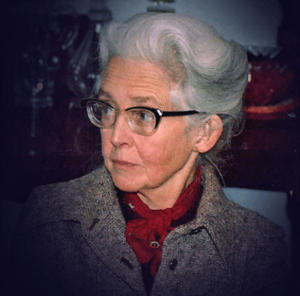Mary Eily de Putron facts for kids
Quick facts for kids
Mary Eily de Putron
|
|
|---|---|
 |
|
| Born |
Mary Eily de Putron
8 July 1914 Dublin, Ireland
|
| Died | 9 February 1982 |
| Other names | M. E. de Putron |
| Known for | Archaeology and stained glass artist |
Mary Eily de Putron (1914–1982) was a talented artist and archaeologist from Ireland and Guernsey. She was famous for her beautiful stained glass artwork. Mary also helped her country during World War II by serving in the Women's Auxiliary Air Force (WAAF).
Contents
Early Life and Education
Mary Eily de Putron was born in Dublin, Ireland, on July 8, 1914. Her parents were Annie Kate Shaw and Cyril de Putron. Her father was a captain in the army, originally from Guernsey. Mary was their only child.
The family lived in Ireland for many years. Later, they moved to the Channel Islands when her father retired from the army. Mary went to school at Ladies' College in St Peter Port until 1931.
Discovering Archaeology
After finishing school, Mary de Putron became an assistant in archaeology. She worked on exciting digs, which are places where people dig to find old objects. In Guernsey, she helped explore the Le Déhus dolmen, an ancient burial site. She also worked at Delancey Park.
Mary also joined famous archaeologists like Mortimer Wheeler at Verulamium. This was a Roman site in England. In 1933, she started working as a researcher at the National Museum of Ireland in Dublin. She had already helped with a dig at Islandbridge. This was where old items were found while building the Irish National War Memorial Gardens.
At just 20 years old, Mary became a member of the important Royal Archaeological Institute. She continued to work on many digs in Ireland. These included Poulawack Cairn, a stone fort called Cahercommaun, and ancient lake dwellings called crannogs. She worked with the Harvard Archaeological Expedition on these projects.
When she wasn't digging, Mary drew pictures of the old objects found at the museum. She worked with the museum's artist, Eileen Barnes. In 1935, Mary left the museum to study archaeology at University College London. She earned her diploma in 1938. After that, she worked in England and Guernsey with other archaeologists. She also worked closely with Dorothy Liddell, helping to finish her work when Liddell became ill.
Serving in World War II
When World War II began in 1939, Mary de Putron returned home. Then she went to England and joined the Women's Auxiliary Air Force (WAAF). This was a special part of the air force for women. She started as an Aircraftwoman and was promoted to Flight Officer by 1943.
Mary was recognized for her service in 1945. She also received two medals: the 1939–1945 Star and the War Medal 1939–1945. The war stopped Mary's career in archaeology. By the time it ended, her home island had been taken over, and she had lost her father and uncle.
Creating Stained Glass Art
During the war, Mary de Putron enjoyed sketching at the Victoria and Albert Museum. There, she met Joan Howson, and they became good friends. They worked together on the Westminster Abbey stained glass windows. They carefully removed some windows to protect them from war damage. They also helped restore other windows until 1951.
Their teamwork brought Mary attention. Soon, she began designing and installing her own windows. Her first window was in 1950 at the chapel at Bradfield College in England. She also created windows for churches in Guernsey, East Hendred, and Stoke Climsland. Many of her beautiful windows can be found in the Channel Islands. Mary set up her own studio and workshop in Guernsey after the war.
Mary de Putron became a member of La Société Guernesiaise in 1961. She was also a keen gardener and a member of the Botanical Society of the British Isles. Because of her archaeology experience, she helped the National Trust of Guernsey survey old buildings in 1975. She also wrote articles for local journals. She wrote about her great-uncle's diary and an article about Joan Howson's life and work.
Legacy and Recognition
Mary de Putron passed away from cancer on February 9, 1982. Her beautiful stained glass windows were featured on Christmas postage stamps issued by Guernsey in 1993. These stamps were designed by Jennifer Toombs.
A film of Mary as a young woman from 1932 is kept at the Cinema Museum in London. It shows her visiting with her family in Guernsey.



